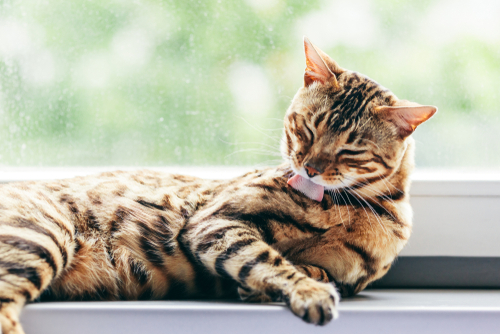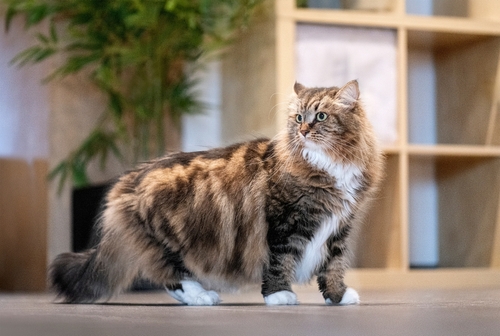With around 73.8 million domestic cats in the United States, there’s no doubt Americans love their feline friends. But, you may be wondering, what are the most common breeds of cats we keep in our homes? What kind of cat would work best as my pet? And do some cat breeds need specific diets?
What are the most common cat breeds in the U.S.?
According to the pet care app Rover, there are roughly 100 recognized breeds of cats around the world, not including all of the unofficial mixes.
Each breed comes with its perks and quirks, making it tough to pick one over another. So, it may help you to choose or identify a cat breed if you know about the 10 most popular cat breeds in America.

1. Domestic Shorthair
Appearance: The Domestic Shorthair, not to be confused with the American Shorthair, can exhibit a wide variety of physical features. Considered the “mutt” of cat breeds, Domestic Shorthairs typically grow to medium size, have short coats, and round faces. Due to their mixed heritage, Domestic Shorthairs can have any mix of colors, often showing up in striped patterns.
Personality: Though often friendly and affectionate, Domestic Shorthairs’ personalities can vary as much as their appearance. Their wide range of personality traits is what makes them very adaptable and, therefore, very popular.

2. American Shorthair
Appearance: Unlike the Domestic Shorthair, the American Shorthair meets specific breed standards. Bred to be hunters, American Shorthairs are generally athletic, muscular, and grow to be medium to large in size. Their heads are broad and round, and their coats are short and plush, commonly displaying tabby markings.
Personality: American Shorthairs make great family pets due to their playful and affectionate temperament. It’s important to engage an American Shorthair in play with interactive toys and puzzles to exercise their natural hunter instincts.

3. Domestic Longhair
Appearance: Domestic Longhairs, like their Shorthair cousins, are of unknown lineage. Being the long-haired “mutt,” Domestic Longhairs come in a wide range of colors and patterns. Living up to their name, though, Longhairs have long, luxurious coats with tufts around their ears and paw pads, requiring frequent grooming.
Personality: Like other popular cat breeds, Domestic Longhairs are often curious, intelligent, independent at times, and affectionate at others. As a mixed breed, Longhairs are quite adaptable to different environments.

4. Siamese
Appearance: One of the more recognizable breeds, Siamese cats have pale-colored bodies with gray-brown points (face, ears, legs, and tail). They have short, fine coats and a long, athletic stature. Their slanted, almond-shaped eyes are most often a striking shade of blue.
Personality: Siamese are considered the extroverts of the cat community, often bonding closely with their person. They’re incredibly intelligent, affectionate, and chatty, frequently vocalizing their low-pitched voice known as a “meezer.” It’s important to keep in mind that because of their dependent nature, Siamese cats can suffer from separation anxiety. So, they benefit from having another pet friend or an owner who is home most of the time.

5. Maine Coon
Appearance: A very large breed of cat, Maine Coons are thought to be native to North America. They’re identifiable by their impressive size, long coat, and pointed ears with tufts. A Maine Coon’s tail is normally as long as its body to wrap around for extra warmth.
Personality: Maine Coons make wonderful companions to owners who appreciate massive cats and are willing to frequently groom them. Their affectionate and playful nature makes Maine Coons a very popular breed in the U.S. and beyond.

6. Ragdoll
Appearance: Ragdoll cats are known for their large, fluffy bodies and distinct coloring. Like Siamese, Ragdolls are a pointed breed, meaning they have light-colored bodies with darker fur around their face, ears, legs, and tail. Their bright blue eyes are often framed by a broad face and neck ruff.
Personality: Ragdolls have go-with-the-flow attitudes and are quite affectionate. Like other breeds, Ragdolls are curious, but generally enjoy lounging more than playing. While they’re known for their “floppy” manner, Ragdolls have the same pain thresholds as other cats. So it’s important to handle Ragdolls as carefully as you would other breeds.

7. Russian Blue
Appearance: Since their introduction to America in the early 1900s, Russian Blues have risen in popularity. They can be identified by their plush, silvery coats and regal-looking faces. Russian Blues normally have large, rounded ears, straight noses, and beautiful green eyes.
Personality: Russian Blues are sweet-mannered and loyal to their humans. While they’re affectionate towards their family, Russian Blues enjoy their alone time and tend to hide when company comes over.

8. Bombay
Appearance: The mini panther of domestic cats, the Bombay breed was originally introduced in the 1950s by crossing a Domestic Shorthair with a Burmese cat. Bombay features include a short, all black coat and bright yellow eyes.
Personality: Bombay cats are known for their intelligence and playful personality. Bombays are reportedly easy to train, which explains their growing popularity.

9. Bengal
Appearance: The Bengal’s sleek, marbled coat is probably its most identifiable feature. Bengals are considered a hybrid species, being a product of a domestic cat and an Asian Leopard Cat. Their unique spotting makes them a very desirable pet in the United States.
Personality: Though they look like wild animals, Bengals can be very mild-mannered and affectionate. To entertain their wild side, Bengals require frequent playtime and stimulation to stay happy.

10. Siberian
Appearance: Also known as a Siberian Forest Cat or Moscow Longhair, Siberians are a medium to large cat breed from Russia. Because they were allowed to evolve without human intervention, Siberians have thick, triple-layered coats of varying colors and patterns.
Personality: Often compared to dogs, Siberians have an adventurous spirit. Their affection and loyalty make them excellent companions. Along with frequent grooming, Siberians require consistent playtime and enrichment.
Do cats need breed-specific food?
For most common cats, breed-specific diets aren’t necessary as long as they’re receiving nutritionally complete food. However, if you have a high-energy breed such as a Bengal or Siberian, it may be beneficial to try a high-protein, grain-free diet. Talk to your vet about your cat’s breed-specific options.
Find nourishing, wholesome kibble, pate, and treats for every cat breed here.